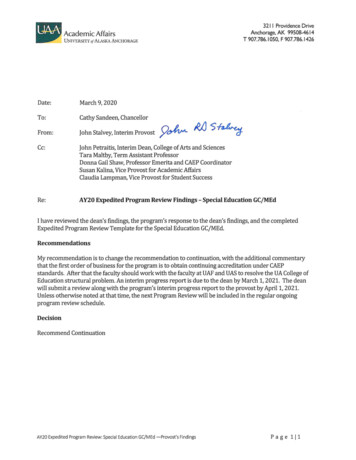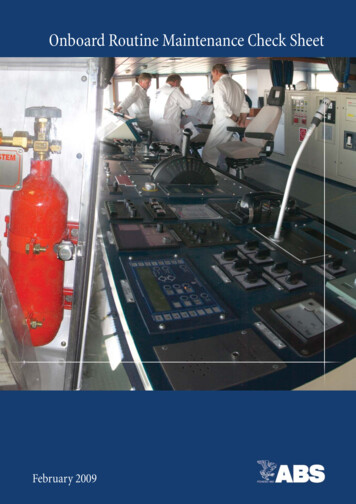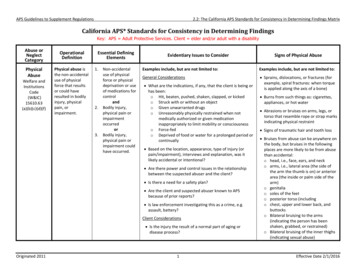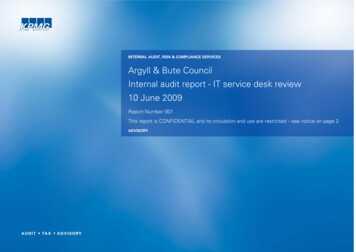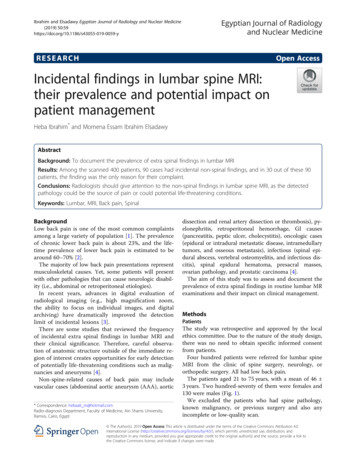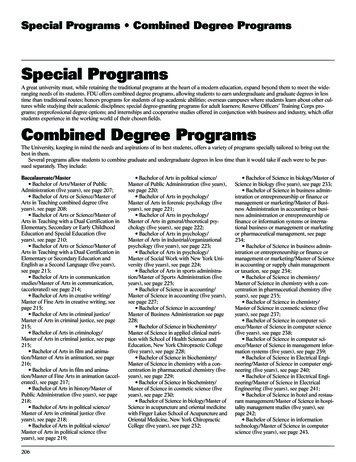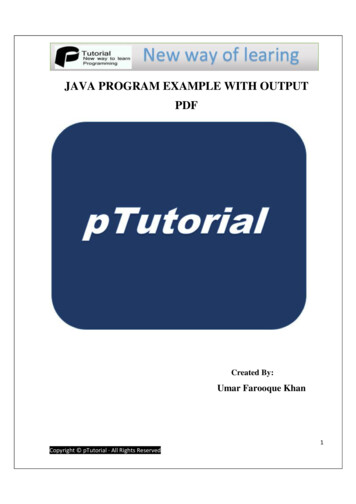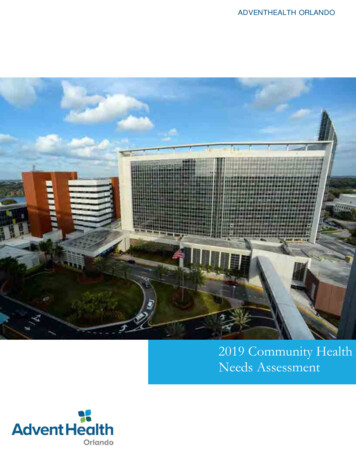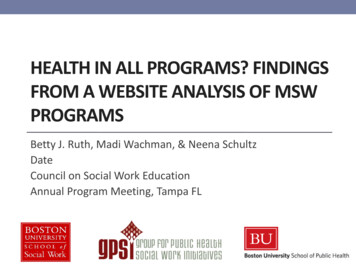
Transcription
HEALTH IN ALL PROGRAMS? FINDINGSFROM A WEBSITE ANALYSIS OF MSWPROGRAMSBetty J. Ruth, Madi Wachman, & Neena SchultzDateCouncil on Social Work EducationAnnual Program Meeting, Tampa FL
Presenter DisclosuresBetty J. RuthThe following personal financial relationships withcommercial interests relevant to this presentationexisted during the past twelve months:No relationships to disclose.
OVERVIEW: HEALTH, SOCIALWORK, AND A CHANGINGLANDSCAPE
Social Work and Health: Changing TimesMultiple drivers forcing increased focus onhealth in social work: Population changes, globalization,urbanization, aging, growth, immigration Natural disasters and war Pervasive chronic/infectious diseases Rampant health inequalities Affordable Care Act
Super Driver: Affordable Care ActMoment of profound change & (imperfect)opportunity to increase health justice ACA goals based loosely on “triple aim”:Better patient outcomes & increased access to care2. Control of costs; getting more for money spent3. Improving population health outcomes1. ACA strategies: incentivize coverage, coordination,community-based services, prevention, integrationof behavioral health into primary care, & costsavings
ACA: Focus on Prevention & Population Health ACA contains population healthgoals/language: explicit linking of clinicalmedicine, health system improvements, &population-based approaches ACA expands access to preventive care;establishes first-ever National PreventionStrategy (NPS); creates funding for prevention,including Prevention and Public Health Fund(Kemp, 2012)(Fielding, Teutch, & Koh, 2012)
ACA: Population Health (PH) Defined Refers to health outcomes of groups of individuals,including distribution of group differences(Kindig & Stoddart,2003) Measures health inequalities in & between groups,particularly “social determinants of health” education, class, race, access to care, etc. Includes policies & interventions for improvingpublic’s health through “wide-lens approaches,”historically tied to greatest population health gains(Beddoe, 2013; Braverman, Edgerter, & Williams, 2011; Moniz, 2010)
ACA: Defining Wide-Lens ApproachesWide-lens public health approaches include: Population level efforts to create healthycommunities and environments Prevention, health promotion, health advocacy Study of social and structural causes of and solutionsto poor health outcomes or inequalities – “socialdeterminants of health” Integration of health into all policies and systems Historically, wide-lens public health approaches yieldgreatest improvements in health and are highly linkedto health equity
SOCIAL WORK IN HEALTH INTHE ACA ERA
ACA Impact on Social Work (SW) ACA affecting all core health professions, including SW Majority of US social workers employed in health:impact likely to be great Potential for expanding SW opportunities in: navigation and care coordination integration of behavioral health & primary care patient-centered health homes accountable care organizations community-based health services prevention and wide-lens practices to improve population health
Historical Examples of Wide-Lens SWEarly 20th century SW characterized by wide-lens: Embrace of public health model Collaboration with public health in infectious diseasecontrol, maternal & child health, settlement houses,hospital SW Early use of social determinants of health through“person in environment” approaches Prevention, case-finding, early intervention Development of public health social work and“macro” or community approaches
SW in Health Today: Mostly MicroToday, most SW in health “close-up” and micro: Health generally viewed as niche area of practice—largely clinical in nature--focused on counseling,treatment, psychosocial support Critically valuable to individual and family well-being,but limited in population impact ACA offers opportunity to redefine health in SW usingbroader framework that once again embraces widelens approaches, broadens profession’s reach &strengthens SW impact(Beddoe, 2013)
SW Health Impact Model: Increasing theProfession’s Impact on Health InequalityThe big social justice issues, such as health inequalitiesborn of social determinants of health, require reconceptualization of SW in health for greater impact: Challenge is not to abandon existing clinical/macromethods, but to enhance profession’s overalleffectiveness by widening practice to deliberatelyembrace all levels of health impact model The SW Health Impact model, adapted from Frieden’sHealth Impact Model, illustrates why SW is one ofvery few professions with capacity and history forimpacting health on multiple levels (Frieden, 2012)
SW Health Impact ModelCreating health equitythrough structuralchange effortsdirected at SDOHAddressing Social Determinants pactInfluencing Systemswithin the CurrentContextPrevention ented ClinicalInterventionsSocial reform effortswithin systemto achieve incrementalchangeHealth promotion &prevention uticinterventions,psychosocial support
SW Health Impact Model Summary The Bad News: Most SW in health occurs at tip ofmodel, where population impact is least The Good News: We have within our ranks currentand historical capacity to work at all four levels Even Better News: We can educate students and SWprofessionals for greater impact in health The Best News: SW in health can become importantforce for social justice, health equity and success ofACA
HEALTH CONTENT IN SWEDUCATION
Health Content in SW EducationLittle knowledge regarding health contentin SW education: Historic concern that graduating studentsunprepared for practice in health(Bronstein, Kovacs & Vega 2007;Spitzer & Davidson, 2013) Scholarly discussion of role of public healthcontent in SW education ongoing since 1970s(Ruth & Sisco, 2008) Robust inquiry into various gaps/missingcontent in SW education e.g. suicide, healthyaging, domestic violence(Danis & Lockhart, 2003; Marshall & Altpeter, 2005; Ruth,Gianino, Muroff, McLaughin & Feldman, 2012 )
Health Content in SW Education Trends Most recent review of health content in 1997: half of MSWprograms offered health-related courses (Kadushin & Egan, 1997) More recently, one quarter of MSW programs appear to offerprevention content (McCave & Rishel, 2011) Sharp increase in MSW/MPH programs suggests interest inpublic health wide-lens approaches (Ruth et al., 2013 ) Growing recognition that ACA era requires significant changesin SW education including recommendations for Increased prevention and public health content Increased care coordination, integration, behavioral health content Development of health concentrations in all MSW programs Requiring health care social work content for reaccreditation (Collins, 2013;Reisch, 2013; Zabora, 2013)
THE HEALTH IN ALL MSWPROGRAMS STUDY (HIAPS)
The Origins of the TitleOur Title: “Health in all Policies:” global public health strategy for improvingpopulation health by addressing complex factors that influencehealth; goal is to make health central to ALL policy Refers to collaboration necessary to impact social determinants ofhealth: food systems, transportation, neighborhood, childcare,education, & access to health care “Health in all MSW Programs,” acknowledges growing importanceof health as over-arching social justice framework in SW If, as SW Health Impact Model suggest, that all social workers areengaged in addressing social determinants of health, then “allsocial work is health social work” (Bywaters & Napier, 2009) Thus, there should be “Health in all MSW programs!”
Methods: HIAPS RationaleStudy Rationale: To establish baseline understanding of amount and type ofhealth language in MSW program missions and health contentin MSW programsFour areas of inquiry:1. Presence of health in MSW program’s mission statements;is wide-lens language included?2. Presence of health courses in MSW programs; are widelens health courses included?3. Presence of health concentrations (Areas of Practice,Specializations, Certificate Programs) in MSW programs;how many contain wide-lens content?4. How many schools offer MSW/MPH programs?
Methods: Content Analysis Team of five researchers conducted content analysis of all availableUS MSW program websites during Spring 2014 Identified sample using 2013-2014 CSWE list of accredited programs A total of 224 MSW programs located; 222 had complete informationavailable online; 1 school had partial information Coded for:1.2.3.4.5.Health in Mission Statements, including wide-lens statementsHealth Courses, including those with wide-lens contentHealth Concentrations (includes Areas of Practice, Specializations, andCertificate Programs, other formal clusters of study), including thosewith wide-lens contentPresence of MSW/MPH programsDemographics
Methods: Sources of Data CSWE website list of all accredited MSWprograms MSW websites Individual MSW program course catalogs Student handbooks
Methods: Coding Process Three rounds of coding: Round 1 focused on general health content Round 2 focused on wide-lens health content Round 3 focused on health in mission statements, including wide-lens Five team members individually reviewed MSW programwebsites coding for health content, including wide-lens, andpresence of MSW/MPH programs Inter-rater reliability assessed by examination of rater codingfor 10% sample – coding consistent on all variables Following development of final coding scheme, 20 schoolscoded, with 100% agreement In situations where there was disagreement, reviewersconverged for consensus coding
Methods: Defining HealthNOT EASY! Challenges included: Lots of health content and very wide-rangingChanging definitions of health e.g., behavioral health, integrativehealth, mind-body healthHealth often coupled with population or other issuesOnce health content identified, wide lens had to be defined andoperationalized for secondary codingThrough iterative discussions: Arrived at meaning/definition of wide-lens content in social workRelied on emerging body of literature on wide-lens curriculum in SWeducation (Crisp & Beddoe, 2013; Frieden, 2012; Bywaters & Napier, 2009)Anchored terms and content in Social Work Health Impact Model
Methods: Mission Statement CodingAll 224 MSW programs reviewed for mission statements: Roughly 95% of all schools (n 215) posted mission statementsonline All mission statements coded for following terms: health (including mental health), health equity, prevention, socialdeterminants of health All schools which coded “yes” for any of above terms were sub-coded for “wide-lens” as defined by: health equity, prevention, social determinants of health, healthpromotion
Methods: Course CodingTwo phases of course coding:1. Coding of any health or health-related courses by titles anddescriptions2. Coding any of the above as “wide-lens” if course titles anddescriptions contained substantive content on ANY of the following: Prevention, health promotion, social determinants of health, healthdisparities, health equity, public healthSocial/structural models of causes or solutions to health problems andhealth inequalitiesHealth/mental health policy, systems of health care delivery, &integration of health content in all policies and systemsPopulation-level efforts to create healthy communities and environments
Methods: Concentration CodingThe term “Health Concentrations” refers to multiples ways MSWprograms enable student focus on health, such as Areas ofPractice, Specializations, Concentrations, and CertificatePrograms First, Health Concentrations were identified and coded; Health Concentrations were sub-coded as “wide-lens” if theyincluded two or more wide-lens courses, as defined previously
FINDINGS
Demographics of our Sample Total MSW programs: 224; 222 had complete informationavailable; 1 had partial information Organization of Curriculum: Methods only (clinical; macro; generalist): 42.2% (n 94) Concentrations only (AOP, specializations): 14.3% (n 32) Both/Hybrid (includes Methods with certificate programs): 42.6% (n 95) State/Private: State: 72.6% (n 162) Private: 27.4% (n 61) Religious Affiliation: 13.9% (n 31) MSW/MPH Programs: 18.8 % (n 42)
Findings: Mission StatementOf the 215 schools with mission statements: 14.9% (n 31) contained health language 6.0% (n 13) had wide-lens health language
Examples: Mission StatementsHealth-Related Example – Fayetteville State University:“The mission of the Master of Social Work Program (MSW) at Fayetteville StateUniversity (FSU), which is consistent with the profession’s purpose and valuesand program’s context, is to prepare students for advanced social workpractice and leadership with a focus on issues concerning children, families,the military, mental health and substance abuse.”Wide-Lens Health Example – Indiana University School of SocialWork:“The mission of the Indiana University SSW is excellence in education,research and service to promote health, well-being, and social and economicjustice in a diverse world.”
Findings: General Health-Related Courses About 8,000 courses reviewed Approximately 93% schools offered health-related courses Strong emphasis on micro practice courses: about three-quarters (73.1%) appeared to be clinical courses focused onindividual or family well-being and coping Changing language of heath courses: few “medical social work”(11.11%), trend toward terms such as “behavioral health” Only 38.5% (n 86) schools offered any wide-lens courses Less than 20% offered more than one wide-lens course
Findings: Wide-Lens Courses706061.7%50403018%2013.1%105.4%2.3%0No WL CourseOne2 or 3Wide-Lens Courses4 to 67 or moren 222
Examples: Health Courses(Arranged by SW Health Impact Model)Addressing Social Determinants of HealthEnvironmental Justice & Community Health (Howard)Social Determinants of Health (University of New England)Influencing Systems within the Current ContextQuality Health Care For Vulnerable Populations: Accessibility, Availabilityand Affordability; Health Care Policy, Advocacy, and Design Making(Catholic University)Community & Public Health Practice (U of Hawaii @ Manoa)wider-lensPrevention & Resilience PromotionapproachesPrevention of Addiction & Related Problems(Florida International)Developing Community Level HIV PreventionInterventions viduallyOriented InterventionsSocial Work Practice withPeople with AIDS &Chronic Illness(Hunter)
Findings: General Observations on HealthConcentrations A total of 35.7% (n 44) had traditional “healthconcentrations” Health concentrations often partnered with topics suchas mental health, aging & trauma; when these areincluded, a total of 127 MSW programs (57.2%; n 222)offer what we termed “health plus” concentrations Only 5.4% (n 12) of all MSW programs offered “widelens concentrations,” as defined by requiring two or morewide-lens courses
Example: Health ConcentrationSouthern University at New Orleans’ Health/Mental HealthConcentration, characterized by health content (not wide-lens):Health/Mental Health SOWK 732: Practice Issues in Health and Mental Health SOWK 734: Empowerment Based Social Work AndHealth/Mental Health Care SOWK 750: Empowerment Based Practice in Mental Health SOWK 751: Chemical Dependency
Example: Wide-Lens Health ConcentrationMorgan State University’s Public Health Social WorkConcentration, characterized by wide-lens course content:Public Health Social Work SOWK 650: Social Work Practice in Health and DiseasePrevention SOWK 651: Epidemiology SOWK 652: Maternal and Child Health Macro Practice,Programs and Policies SOWK 653: Public Health Policy, Urban Health Services, Issuesand Planning
Limitations Content analysis based on static view of MSWprograms’ web presence; some content may not havebeen current Quantity of available online information unequal fromschool to school Inconsistencies in health-related language posedcoding challenges; euphemistic health terms, such aswell-being, were not coded Course and concentration titles/descriptions providedlimited picture of actual content
DISCUSSION &IMPLICATIONS
DiscussionObservations: Few schools use health to anchor mission statements; evenfewer use “wide-lens” or broad health framework MSW program health content, though plentiful, focused largelyon clinical practice in health settings Health content generally framed as “niche area of practice,”not overarching framework for population health Changing terminology: less medical SW, more behavioral health Limited wide-lens content in MSW courses or concentrations Some schools show signs of shifting MSW content towardwide-lens approaches, but still limited to small minority
Implications Health inequality and downturn in nation’s healthcannot be arrested without substantive engagementin population health No profession can stay outside the population healthframework and thrive in the ACA era! SW has important roles to play in helping ACA achieveits goals, including promotion of population health To be effective, SW must widen its lens to includeprevention and other population healthapproaches what Reisch (2012) calls the “return to thefuture” for SW and SW education
Recommendations for SW EducationRecalibrate SW education to respond to ACA: Shift from viewing health as “niche area of practice” toupdated broad conceptualization of health--“all SW ishealth SW”-- which will empower SW in larger healthenvironment Rebrand SW as unique profession dedicated to healthequity, through explicit focus on social determinants ofhealth and intentional practice at all levels of Social WorkHealth Impact Pyramid Integrate ACA skills into SW education: health advocacy,policy analysis, coaching, measurement of SW impact onhealth outcomes, prevention, wide lens approaches Elevate/enhance “traditional” SW practice strengths skills:cultural responsiveness, person-in-environment approaches,inter-professional teamwork, integration, care coordination
A Final Quote“ It is the responsibility of social workers in thehealth care field to adapt their practice skills,their education for practice, and their researchfocus to increase the likelihood that health carereform will produce its intended results (of)greater well-being and a reduction in healthdisparities”(Reisch, 2012)
Acknowledgements Members of the Group for Public Health Social WorkInitiatives: Esther Velasquez, Jamie Wyatt Marshall,Sara S. Bachman, Lianne Hope BUSSW research assistants: Brita Orwoll, MSW, MPH;Ashley Fryer, BA; Nermeen Tahoun, B.S. BUSSW Associate Dean Ken Schulman The generous donors to the Boston UniversityMSW/MPH Program and the Group for Public HealthSocial Work Initiatives
Contact usThank you for joining us today! Please contact us: Madi Wachman, MSW madi@bu.edu Betty J. Ruth, MSW, MPH bjruth@bu.edu
Most recent review of health content in 1997: half of MSW programs offered health- related courses (Kadushin & Egan, 1997) More recently, one quarter of MSW programs appear to offer prevention content (McCave & Rishel, 2011) Sharp increase in MSW/MPH programs suggests interest in public health wide-lens approaches (Ruth et al., 2013 )

